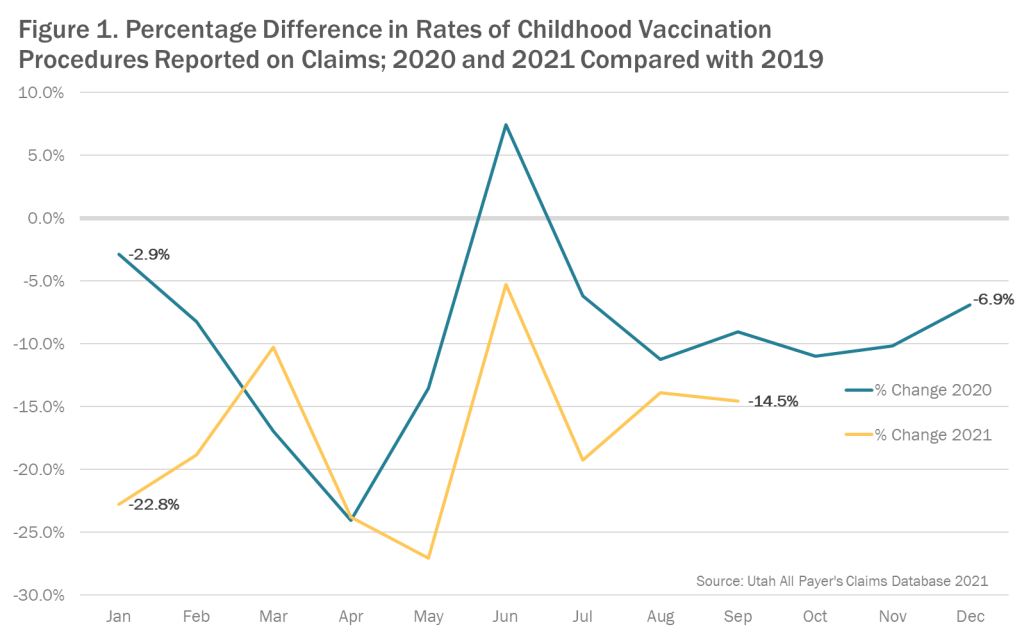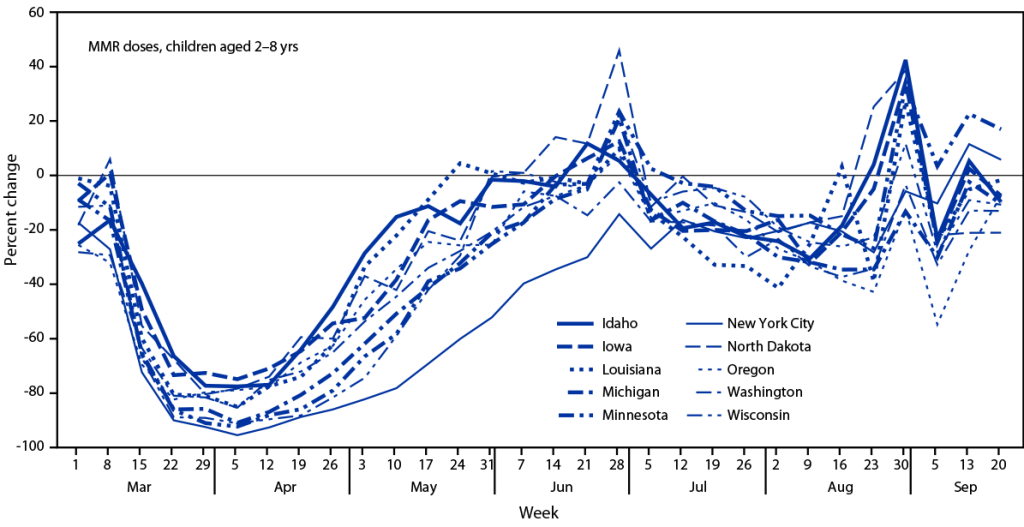By: Brantley Scott & Hunter Doyle
According to the Centers for Disease Control and Prevention [1], pediatric vaccine orders and administration saw a significant decline at the start of the COVID-19 pandemic in 2020. Given the pandemic continued beyond a year, the Utah Department of Health Office of Health Care Statistics sought to examine the current trend of insurance claims for this standard preventive health practice in our state.
To observe these trends, data from the Utah All Payers Claim Database (APCD) from 2019 through 2021 were analyzed. The claims for vaccines measured in this report are depicted in the National Committee for Quality Assurance (NCQA), Childhood Combination Status 3 [2]. Vaccination claim rates were calculated by dividing the number of vaccine procedure counts by the number of APCD members aged 0–6 years.
This age range was used because childhood immunizations are completed by age 6, according to the Centers for Disease Control and Prevention (CDC) Vaccination Schedule [3]. A vaccination rate was calculated to control for changes in the Utah APCD population. The denominator for this rate represents APCD members in Utah from 0 to 6 years of age. The numerator is the number of vaccination procedures in claims for the following vaccines: diphtheria, tetanus, and whooping cough (DTaP), inactivated poliovirus vaccine (IPV), measles, mumps, and rubella (MMR), haemophilus influenzae type B (HIB), hepatitis B virus (HBV), varicella (VZV), and pneumococcal conjugate vaccine (PCV). To facilitate comparison of vaccination claim rates year to year, the rate difference was calculated for each month of 2020 and 2021, using 2019 as the baseline rate. The 0% line in the graph represents the 2019 vaccination rates in Utah, used as a pre-pandemic comparison, which allows for comparison of the monthly fluctuations in change.

Utah’s statewide stay-at-home order may explain the low vaccination rate between March and April 2020 [4]. Additionally, there is some evidence to suggest 2019 may have had a higher number of vaccinations than previous years, which means the comparison may be to a peak year and a decline may not represent an actual decrease from a typical year [5]. Other factors that may influence these lower vaccination rates, such as the number of vaccines outside the Utah APCD, were not examined. While the exact cause of this lower observed vaccination rate is unknown, data from 2020 and 2021 showed similar trends.
When other states are observed, Utah is not an outlier with regard to a decreased rate of childhood vaccinations. Figure 2, below, comes from the CDC’s Morbidity and Mortality Weekly Report (MMWR) [6] and depicts how 10 jurisdictions were affected by the pandemic for individuals ages 2-8 for MMR vaccinations in 2020. The CDC indicates these states showed a rebound in June. However, the July to September time period was not enough to “achieve catch up coverage.” Simply hitting pre-pandemic numbers is not enough, but being consistently above the threshold will result in increased disease coverage.
Figure 2. Percentage Change in Measles, Mumps, and Rubella Vaccine Doses Administered to Children Aged 2–8 Years* March–September 2020 Compared with the Average Number of Doses Administered During the Same Period in 2018 and 2019 — 10 U.S. Jurisdictions

*During March–May 2020, eight of the 10 jurisdictions implemented some form of stay-at-home order; no orders were issued in Iowa and North Dakota. Source: https://www.cdc.gov/mmwr/volumes/70/wr/mm7023a2.htm
Jessica Payne MPH, an epidemiologist from the Utah Department of Health Immunization Program stated [7]:
“By all measures [8][9], it is clear that over the course of the COVID-19 pandemic, many, many childhood vaccinations were missed and are now overdue. It is essential that parents, physicians and public health providers work together to make sure our children get caught up on missing vaccination as soon as possible. Community immunity from vaccine preventable diseases like measles, pertussis, and hepatitis rely on high immunization rates. In order to protect those most vulnerable in our communities, we need to ensure that missed vaccination appointments are made up quickly. We encourage all parents to reach out to their child’s physician and find out if their child is overdue for any vaccinations.”
The pandemic has impacted healthcare in many ways. The claims data from the Utah APCD suggests the number of preventive childhood vaccinations administered may be one of those areas impacted. It may be worthwhile to collectively discuss ways to increase vaccination rates to prevent future childhood disease outbreaks. If we prioritize vaccinations, we can continue to keep Utah’s children healthy, while inhibiting future onset of vaccine-preventable diseases. By prioritizing vaccinations, we are able to continue to keep Utah’s children healthy, while inhibiting future onset of vaccine-preventable diseases.
There are a number of limitations of this analysis that must be considered. This analysis utilizes claims in the APCD. The APCD does not include all persons in the Utah population and may not include all claims for each person. There may be multiple vaccinations per procedure. This analysis looked at procedures not vaccinations. This analysis also did not assess vaccinations per person per the vaccination schedule. Consequently no conclusions regarding trends of vaccination rates for children can be drawn from this data. Additionally the baseline year may be a high year according to other data [5] and so the decline may not represent decline from a typical year. This analysis only shows changes in claims for vaccinations from the data that is in the APCD.
[1] https://www.cdc.gov/mmwr/volumes/69/wr/mm6919e2.htm [2] https://www.ncqa.org/hedis/measures/childhood-immunization-status/ [3] https://www.cdc.gov/vaccines/schedules/hcp/imz/child-adolescent.html [4] https://coronavirus.utah.gov/stay-at-home/ [5] https://ibis.health.utah.gov/ibisph-view/indicator/view/Imm4313314.UT_USNew.html [6] https://www.cdc.gov/mmwr/volumes/70/wr/mm7023a2.htm [7] Utah Department of Health. Immunization Coverage Report, State of Utah, 2021. Salt Lake City, UT: Utah Department of Health; November 2021. [8] https://immunize.utah.gov/wp-content/uploads/2021/12/2021-Immunization-Coverage-Report_Pandemic-impacts-on-vax-orders-and-admins.pdf [9] https://immunize.utah.gov/information-for-the-public/utah-statistics/